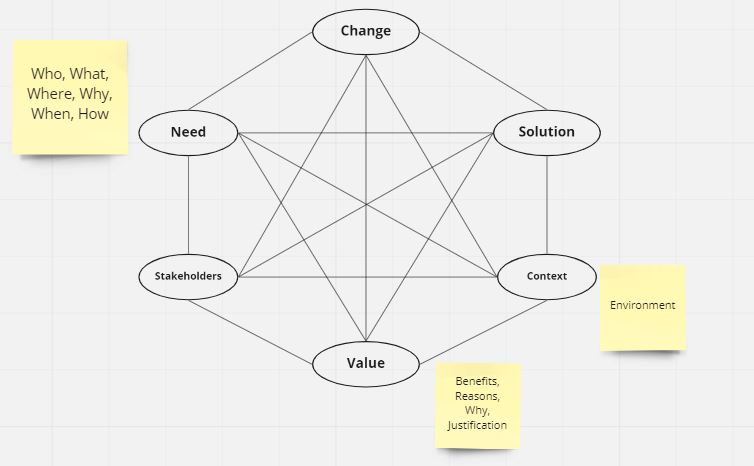Business Analysis Core Concept Model (BACCM)
Business Analysis Core Concept Model or BACCM because let’s be honest the full form is quite a mouthful sounds a bit intimidating at first but it is actually quite easy to understand and is a foundational model for all business analysts.
BACCM is a conceptual framework outlined in the Business Analysis Body of Knowledge Guide (BABOK Guide). Its main purpose is to establish a common terminology for business analysts to discuss their work irrespective of their industry or methodology. It also helps establish a relationship between the six core concepts which helps evaluate their individual and combined impact or progress at each point of the project.
To put it simply, it helps break down any business situation into six commonly accepted terms that are interrelated to each other that helps a business analyst understand, analyze and provide a business solution more efficiently and effectively.
The six core concepts of BACCM are as follows:
- Need
- Change
- Solution
- Stakeholder
- Value
- Context
All the concepts are interrelated to each other and each is equally important. One cannot define need without understanding the context or presenting a solution without considering the stakeholder’s perspective. Therefore, one needs to understand each of these concepts individually, their relationship with each other, and their impact collectively to analyze any business solution.
Let’s understand these individual terms and their relationship with each other.
- Need: In essence, it is the situation that demands business analysis in the first place. This could be any business situation, opportunity, or restriction that needs to be analyzed to be solved. For example, if one notices that there has been an increased expenditure at home. Increased expenditure would therefore be categorized as the need
- Stakeholders: These are the individuals, groups, or organizations who are involved in the specific situation and can either affect it, impact it, or both. Continuing with the same example above, the stakeholders in the situation would be the family members residing in the house. Each of these stakeholders would also have their own individual needs
- Solution: It is simply the solution to a problem or opportunity i.e. whatever needs to be done to provide the most favorable solution in any need. In a business context, it could be a process change, innovation like developing new software, or any organizational change. Following the above example, a solution for increased expenditure would be to cut certain expenses keeping the stakeholders’ needs and considerations in mind
- Context: It can be considered as the environment where the stakeholders and our solution will exist. The context has an impact on the solution and it’s feasibility as well as the stakeholders and needs. For example, in the above example – we can cut increased expenditure at home by shutting off appliances when not in use but the same solution may not be feasible for a 24/7 convenience store
- Value: Value can be understood as the ‘why’ part of BACCM. It is simply the benefit or reason behind why the project should take place. Value is what the stakeholders get out of the endeavor, how it serves the need within a context, and drives the solution. In the example above, cutting down expenditure would result in increased saving (for the stakeholders) that may help in the future (context) which further motivates them to do so thereby, driving the solution
- Change: It is the action taken to address the situation or need. So, it is what one needs to do to achieve the solution. Continuing with the same example as before, to cut down the expenditure (solution) – we need to let go of certain unnecessary expenses (change) after talking to the family members (stakeholders) once they understand that it will increase our savings and therefore, the value of the action on our finances (context)

As you may have already noticed, each of the core concepts are fundamentally interrelated and impact one another. The BACCM helps dissect and categorize any business situation in these six concepts which aids the business analyst to organize and examine the said problem and provide better solutions. In simplified terms, it helps break down the situation as ‘who, where, what, why, when, how, situation and solution’ which puts things in perspective for the business analyst as well as the other people involved.
BACCM serves as a map to any situation thrown at an analyst and enables them to be a better navigator in any business situation. The model serves as a foundation for any business analyst or those interested in understanding the business analysis better.

